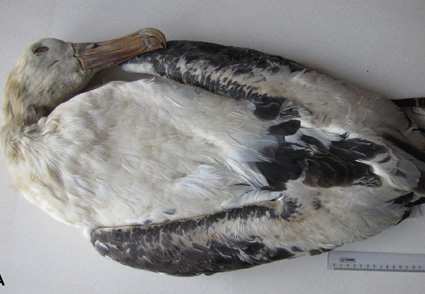Abstract
The Short-tailed Albatross Phoebastria albatrus (Pallas, 1769) is a threatened seabird widely distributed in the northern Pacific Ocean with its largest breeding sites on the Senkaku Islands and Torishima Island, Japan, which are separated by over 1700 km. A recent taxonomic revision based on morphological, behavioral, and DNA sequence evidence has revealed that this species consists of two cryptic species: a smaller species which breeds mainly in the Senkaku Islands, and a larger species which breeds mainly on Torishima Island. However, it has remained unclear to which of these species the scientific name Phoebastria albatrus applies, because the type specimens are lost. Here a neotype is designated to resolve this taxonomic issue. From now on, the scientific name Phoebastria albatrus should be applied only to the smaller species breeding on the Senkaku Islands. The name of the larger species is more problematic, as the types of each synonym of P. albatrus must be traced, found, and examined.
References
BirdLife International (2018) Phoebastria albatrus. The IUCN Red List of Threatened Species 2018. https://doi.org/10.2305/IUCN.UK.2018-2.RLTS.T22698335A132642113.en
Carboneras, C., Jutglar, F. & Kirwan, G.M. (2020) Short-tailed Albatross (Phoebastria albatrus), version 1.0. In: del Hoyo, J., Elliott, A., Sargatal, J., Christie, D.A. & de Juana, E. (Eds.), Birds of the World. Cornell Lab of Ornithology, Ithaca. https://doi.org/10.2173/bow.shtalb.01
Eda, M. (2018) Inferring the history of Short-tailed Albatross in Senkaku Islands from field survey on Torishima and zooarcheological samples from Rebun Island. In: Mizuta, T. & Takagi, M. (Eds), Ornithology on Islands. Kaiyu Sha, Tokyo, pp. 77–94. [In Japanese]
Eda, M., Izumi, H., Konno, S., Konno, M. & Sato, F. (2016) Assortative mating in two populations of Short-tailed Albatross Phoebastria albatrus on Torishima. Ibis, 158, 868–875. https://doi.org/10.1111/ibi.12397
Eda, M., Koike, H., Kuro-o, M., Mihara, S., Hasegawa, H. & Higuchi, H. (2012) Inferring the ancient population structure of the vulnerable albatross Phoebastria albatrus, combining ancient DNA, stable isotope, and morphometric analyses of archaeological samples. Conservation Genetics, 13, 143–151. https://doi.org/10.1007/s10592-011-0270-5
Eda, M., Sato, F., Koike, H. & Higuchi, H. (2011) Genetic profile of Deko-chan, an un-ringed short-tailed albatross in Torishima Island, and the implication for the species’ population structure. Journal of the Yamashina Institute for Ornithology, 43, 57–64. https://doi.org/10.3312/jyio.43.57
Eda, M., Yamasaki, T., Izumi, H., Tomita, N., Konno, S., Konno, M., Murakami, H. & Sato, F. (2020) Cryptic species in a vulnerable seabird: Short-tailed Albatross consists of two species. Endangered Species Research, 43, 375–386. https://doi.org/10.3354/esr01078
Hasegawa, H. (2003) From Fifty to Five Thousand: for the Restoration of the Short-tailed Albatross. Doubutsu-sha, Tokyo, 222 pp. [In Japanese]
Hasegawa, H. & DeGange, A.R. (1982) The Short-tailed Albatross, Diomedea albatrus, its status, distribution and natural history. American Birds, 36, 806–814.
ICZN [International Commission on Zoological Nomenclature] (1999) International Code of Zoological Nomenclature. Fourth Edition. The International Trust for Zoological Nomenclature, London, 306 pp.
Krasheninnikov, S.P. (1756) Description of the Kamchatka Land. Volume 1. Imperial Academy of Sciences, St. Petersburg, 438 pp. [In Russian]
Morioka, H., Dickinson, E.C., Hiraoka, T., Allen, D. & Yamasaki, T. (2005) Types of Japanese birds. National Science Museum Monographs, 28, 1–154.
Pallas, P.S. (1769) Spicilegia Zoologica quibus novae imprimis et obscurae animalium species iconibus, descriptionibus atque commentariis illustrantur. Fasciculus Quintus. Lange, Berlin, 34 pp.
Salvin, O. (1896) Family IV. Diomedeidae. In: Saunders, H. & Salvin, O. (Eds.), Catalogue of the Birds in the British Museum. Volume 25. Trustees of the British Museum, London, pp. 440–454.
Strauch, A. (1889) Zoological Museum of the Imperial Academy of Sciences: The Fiftieth Anniversary of its Existence. Imperial Academy of Science, St. Petersburg, 379 pp. [In Russian]
Swinhoe, R. (1874) On a black albatross of the China seas. Proceedings of the Zoological Society of London, 1873, 784–786.
Temminck, C.J. (1820) Manuel d’Ornithologie, ou Tableau Systématique des Oiseaux qui se Trouvent en Europe. Edition 2, Volume 1. G. Dufour, Paris, cxv + 439 pp.
Temminck, C.J. (1829) In: Temminck, C.J. & Laugier de Chartrouse, M. (Eds.), Nouveau Recueil de Planches Coloriées d’Oiseaux. Livr. 79. G. Levrault, Strasbourg, France, 6 pl.
Temminck, C.J. & Laugier de Chartrouse, M. (1820–1839) Nouveau Recueil de Planches Coloriées d’Oiseaux. Volumes 1–5. G. Levrault, Strasbourg, France.
van den Hoek Ostende, L.W., Dekker, R.W.R.J. & Keijl, G.O. (1997) Type-specimens of birds in the National Museum of Natural History, Leiden Part 1. Non-passerines. NNM (Nationaal Natuurisch Museum) Technical Bulletin, 1, 1–248.
Warren, R.L.M. (1966) Type-specimens of Birds in the British Museum (Natural History). Volume 1. Non-Passerines. British Museum, London, ix + 320 pp.


